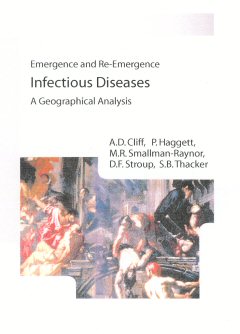

Principal Investigators
Prof Andrew Cliff, Department of Geography, University of Cambridge
Prof Peter Haggett, Department of Geography, University of Bristol
Prof Matthew Smallman-Raynor, Department of Geography, University of Nottingham
Funding
Wellcome Trust. 'Historical geography of emerging and re-emerging epidemics: GIS (Geographical Information Systems) programme', £217,329 , 2000-08.
Project overview
Scientific concern over the global threat of emerging and re-emerging infections has escalated during the last quarter century. In addition to the raft of diseases and disease agents which were newly described from the late 1960s (including Marburg, Lassa and Ebola fevers, Legionnaires' and Lyme disease, HTLV-related leukaemias, toxic shock syndrome, AIDS and hepatitis C), recent years have seen the identification of such potentially lethal conditions as Hantavirus pulmonary syndrome, new-variant Creutzfeldt-Jacob disease (vCJD) and related encephalopathies, Brazilian haemorrhagic fever associated with Sabía virus, and epidemic cholera due to the variant Vibrio cholerae 0139 . The discovery of these apparently 'new' conditions has been accompanied by an upsurge in the virulence, drug resistance, incidence and/or geographical range of such classical infections as diphtheria, influenza, malaria and tuberculosis.
These developments are the most recent in a human history that is replete with instances of the emergence and re-emergence of infectious diseases. In the first half of the twentieth century, for example, Hans Zinsser ( Rats, Lice and History , 1935; Boston: Little, Brown & Co.) provides a classic account of how typhus fever re-emerged from its 'quiet bourgeois existence' to achieve 'mediaeval ascendancy' in Revolutionary Russia. At about the same time, the pandemic of Spanish influenza (1918-19) provides a devastating example of an event associated with the cyclically re-emerging influenza A virus, whilst, in the years that followed, poliomyelitis was to reconfigure itself as one of the great epidemic diseases of the inter- and post-war periods. In earlier centuries, the appearance of smallpox associated with the mild and dispersed variola minor virus (late nineteenth century), the initial pandemic eruptions of Vibrio cholerae (early- and mid-nineteenth century), and the appearance and spread of venereal syphilis in Western Europe (sixteenth and seventeenth centuries) are further historical examples of disease emergence and re-emergence. Numerous other instances, including infamous outbreaks of mysterious diseases in antiquity, can also be cited.
This project aims to understand the processes which appear to have underpinned disease emergence and re-emergence down the ages, and to examine the operation of these factors in particular regional and temporal settings. Case studies drawn from the reports of the field officers of the United States Centers for Disease Control will be used to illustrate the principles involved. These will be supported where appropriate by examples drawn from the wider literature of emerging infections. Finally, the project will look forward, and examine the geographical factors that may have an influence on disease emergence and re-emergence in the twenty-first century. Future patterns of population movement, urbanization, demographic and ecological change are considered, and the problem of the spatial control of future epidemics through quarantine systems is assessed.
Research outcomes
Infectious Diseases: Emergence and Re-Emergence. A Geographical Analysis (OUP, 2008).
